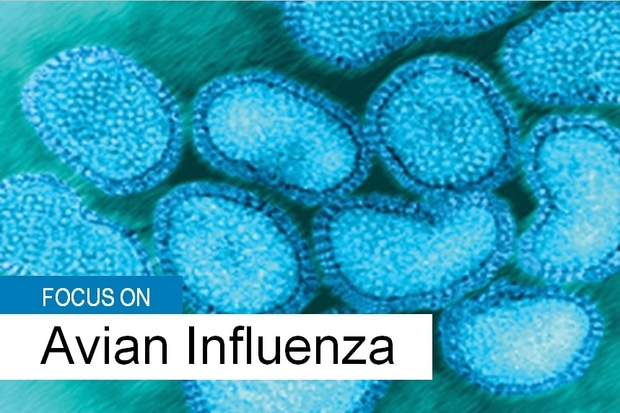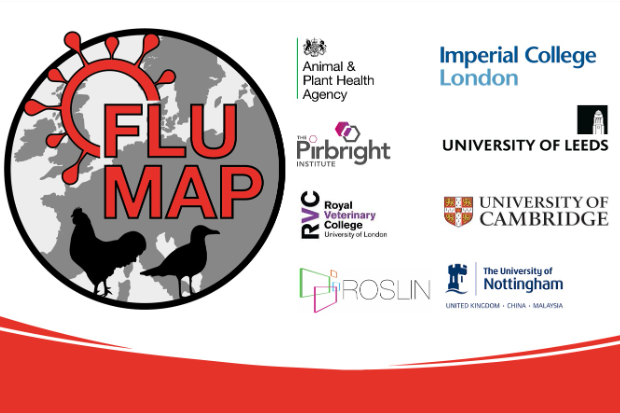https://aphascience.blog.gov.uk/avian-influenza/
Avian Influenza

What is avian influenza?
Avian influenza (AI), more commonly known as bird flu, is an infectious disease caused by viruses whose natural reservoir hosts are wild water birds. The virus naturally undergoes constant and rapid change and can cause devastating worldwide outbreaks in wild birds and domestic poultry within a short space of time.
APHA works all year around to carry out surveillance for notifiable diseases. For avian influenza, we carry out a number of activities to monitor the international disease situation, as well as sampling and testing both wild birds and the farmed bird population.
Unfortunately, in the last couple of years, we have seen increased numbers of diagnosed cases of AI in Great Britain. APHA has been at the heart of the response, from a science perspective, providing all the testing and diagnoses, offering the science evidence in order for disease confirmation and undertaking the epidemiological response to the disease in the field. All these activities support decisions to enable fast and effective control.
Protecting our livestock from notifiable diseases like avian influenza, and supporting industry and UK trade by providing official disease freedom status requires APHA to work across multiple disciplines to understand disease risk, ensure we can detect disease presence, and when we do, act fast to control the spread. APHA is an International Reference Laboratory for AI, providing expert disease advice on AI, both to ensure appropriate response to disease incursions into the UK, as well as to advise countries globally on testing strategies.
Understanding the risks from wild birds and sharing information and advice with poultry keepers helps protect our commercial and other birds whilst controlling outbreaks.
APHA’s remit extends beyond livestock diseases and you can be assured that our teams are ready to respond to a range of animal, plant and bee health threats 365 days a year!
Why FluMap?
FluMap provides a unique opportunity for UK capacity building by providing research training opportunities on an infectious zoonotic animal pathogen consistently threatening global health, economy and food security. The unique reagents generated through this project will be shared across the globe benefiting enormously both the UK and the international scientific community working to reduce the impact of influenza and other infectious diseases affecting livestock and humans both in the UK and beyond. Professional training of postdoctoral research scientists with the capability to work at ACDP level 3 will also be enhanced. The outcome of this research will be shared through several avenues: in several peer-reviewed journals (e.g, Emerging Infectious Diseases, Journal of Virology, PLOS Pathogens, Nature and Nature Microbiology, Emerging Microbes and Infections), by way of 'popular' articles in magazines, Institute news briefs, and by presentations at scientific conferences and targeted professional meetings with a range of stakeholders focusing on control of infectious zoonotic diseases, including influenza. There has already been media interest in the research and its impact on better understanding and controlling the ongoing AI outbreak in the UK. The research will therefore benefit the wider veterinary and human medicine scientific community, directly or indirectly involved in the control and policy development regarding emerging infectious diseases affecting both animals and humans. In summary, the research will provide scientific advancement on understanding AIVs epidemiology, evolution, host-adaptation, pathogenesis and control and will ultimately benefit the wider public good and betterment of public and animal health, welfare, economy and food security.

Project Overview
High pathogenicity avian influenza virus (HPAIV) is a significant burden on animal health, with a risk of human infection that demands continuous monitoring and control globally. Cases of HPAIV into the UK and Europe have increased significantly in the last two winter seasons and continue in the current winter season. During the 2020/21 season, 26 infected poultry premises (IPs) were detected across GB (24 IPs) and NI (2 IPs) with over 300 wild birds testing positive, a record outbreak season at that time. The 2020/21 outbreak was dominated by the detection of the HPAIV H5N8 subtype, although an undercurrent of alternative H5 based subtypes was detected including H5N5 in poultry, and H5N1 and H5N3 also being detected in wild birds. This season was then followed by a significant escalation in cases due to new incursions during 2021/22, with over 100 IPs across the UK, all caused by H5N1 HPAIV. During 2021/22, more than 800 wild birds have tested positive for H5N1 virus, with just a single wild bird detection of H5N8. This project targets this extreme emergence of HPAIV in the UK (and beyond), to improve our understanding of HPAIVs to help mitigate incursions and refine approaches to future prevention strategies.
Work-package 1 aims to improve the understanding of how HPAIV spreads in both wild birds and domesticated poultry. By undertaking biological sampling and data analysis we will design more effective, risk-based surveillance programmes and model the interactions between wild birds and poultry, defining geographical sites and wild bird populations of high risk, and linkages to farms infected with HPAIV. Outputs will enable a greater understanding of the reservoir of infection, wild waterfowl, as well as factors that drive incursion of disease from this reservoir into the poultry sector.
Work-package 2 aims to assess antigenic diversity across the HPAIVs detected in the UK in recent years in context of co-circulating low pathogenicity AIVs, in the absence of disease, both in wild waterfowl and poultry. The sequential emergence of HPAIVs suggests that prior immunity from 2020/21 to H5N8 virus was insufficient to prevent emergence and dominance of H5N1 during 2021/22. This WP will define how antibody responses to different virus surface proteins impact upon the potential of virus emergence. This feature of infection will utilise post-infection antisera derived from natural and experimental infection to study immune escape. Areas of the virus that are identified as being important in the emergence of escape mutants will be further investigated to define where flex exists within viral proteins targeted by the host immune response. This will enable focused studies that will help develop our understanding of what factors might influence future mitigation strategies.
In work-package 3 factors that drive differential disease outcomes, outside of the viral surface proteins, will be assessed. Here, novel systems will be developed to assess viral infectivity and host range which in turn will enhance our understanding of virus-host interactions and define the role of internal viral proteins, critical to viral replication, driving virus diversity and emergence with consequent disease outcomes. WP3 will utilise outputs from WP1 and WP2 to examine the mechanisms that drive the emergence of virus variants, enabling differential adaptation to different hosts. Experimental systems that enable individual components of the viral replicative machinery to be assessed and compared will be developed, utilising our ability to generate viruses in the laboratory to defined genetic specification. Minimal infectious doses and related growth kinetics will be assessed to refine work in animal models. Utilising expertise from across the UK in different experimental systems, with access to a range of laboratory facilities, the partners will link across WPs to generate impactful outputs to enhance our understanding of these emerging pathogens.
Find out more
APHA has published a number of science blogs on the subject of AI. Here are some of our most recent blogs:

Marking this year’s International Day of Women and Girls in Science, learn more about the important scientific work being carried out by our female scientists in the current avian influenza outbreak in this blog and accompanying video.

The bird ‘flu risk to the UK has resulted in APHA confirming a record high number of cases this winter season. We have a major emergency impacting all corners of the UK: learn how we have ramped up to meet the demand and support swift control plus what you can do to help slow the spread of this disease.

Upon confirmation of the presence of avian influenza in the UK, APHA immediately mobilised the National Emergency Epidemiology Group (NEEG). But what is the role of this group and why is it so important? In this blog, we hear from Dr Vicky Kalogeropoulou, Senior Scientific Project Manager and member of the NEEG as she explains more.
How you can help
- Do not touch or pick up any dead or visibly sick birds that you find.
- If you find dead wild waterfowl (swans, geese or ducks) or other dead wild birds, such as gulls or birds of prey, you should report them to the Defra helpline (03459 33 55 77)
- If you keep poultry or game birds, you have a legal requirement to register to the Poultry register if you keep more than 50 birds. You can also voluntarily register if you have less than this number to receive alerts of any disease risks in your area.
- If your poultry or other captive birds are sick or die, contact a veterinarian.

Recent Comments